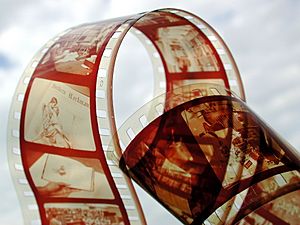Plastic film facts for kids
A plastic film is a super thin, flat piece of plastic. Imagine a really thin sheet of plastic, like the wrap you use for food or the material your plastic bags are made from. If it's thicker, people usually call it a "plastic sheet" instead of a film.
Plastic films are used for tons of different things every day! They help keep our food fresh, make plastic bags for shopping, and are even used to create labels for products. You can also find them in building projects, for gardening, in electronics, and even as photographic film for old cameras or film stock for movies and video tape.
Contents
What Are Plastic Films Made Of?
Almost any type of plastic can be made into a thin film. Here are some of the most common kinds of plastic used to make films:
- Polyethylene: This is the most popular plastic for films. There are different types, like low-density, medium-density, high-density, and linear low-density polyethylene. Each type has slightly different strengths and uses.
- Polypropylene: This plastic can be made into a special kind of film called a cast film.
- Polyester: You might know polyester from clothes, but it's also used for films!
- Nylon: Nylon is another strong material that can be turned into thin films.
- Polyvinyl chloride (PVC): PVC film can be made soft and flexible (with a plasticizer) or stiff (without one).
- Cellulose acetate: This was one of the first bioplastics ever made.
- Cellophane: This film is made from a natural material called cellulose, which comes from plants.
- Bioplastics and biodegradable plastics: These are newer types of plastics that can break down more easily in the environment.
- Semiembossed film: This special film is used as a liner when making rubber products. It helps keep the rubber in good condition and stops dust from sticking to it during the manufacturing process and while it's stored.
How Plastic Films Are Made
Making plastic film usually involves heating plastic until it melts, then shaping it into a thin layer. One common way is called "film extrusion." Imagine a machine that pushes melted plastic through a small opening, like squeezing toothpaste from a tube. This creates a long, thin sheet or tube of plastic. Sometimes, this tube is then blown up like a balloon to make it even thinner and wider before it cools down.
Uses of Plastic Films
Plastic films are incredibly versatile and are used in many different areas:
Packaging and Storage
- Food Packaging: Plastic films are perfect for wrapping food because they can keep air and moisture out, helping food stay fresh longer. Think of the clear wrap on your sandwiches or the bags for chips.
- Plastic Bags: From grocery bags to trash bags, films are essential for carrying and containing things.
- Shrink Wrap: This type of film shrinks tightly when heated, making it great for protecting items during shipping, like the helicopters you see in the images!
- Labels: Many product labels are made from thin plastic film.
Building and Construction
- Vapor Barriers: In buildings, plastic sheets are used as "vapor barriers" to stop moisture from getting into walls and causing problems like mold.
- Landscaping: Films can be used in gardens to prevent weeds or to line ponds.
Specialized Uses
- Photographic film: Before digital cameras, photos were captured on special plastic film that reacted to light.
- Film Stock for Movies and Video Tape: Old movies and video recordings were stored on long rolls of plastic film.
- Electrical Fabrication: Thin films are used in electronics as insulators, meaning they stop electricity from flowing where it shouldn't.
Images for kids
-
Confectionery packaging made of PLA-blend bio-flex bioplastic






